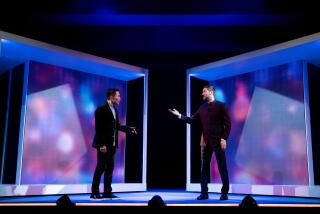THEATER : Intellectualizing With ‘Enemy’ : Andrew Barnicle’s Production of the Ibsen Play Looks at Democracy and the Individual
- Share via
LAGUNA BEACH — The initial concept for Laguna Playhouse’s current revival of Henrik Ibsen’s “An Enemy of the People” was distinctly modern. By shifting the setting to contemporary Scandinavia, director Andrew Barnicle envisioned a staging that would comment directly on today’s problems, especially pollution.
“I was thinking of having PCs (personal computers) and other details of life as it is now on the set,” he recalled. “This was going to be about the here and now.”
It was a reaction--knee-jerk, Barnicle now believes--to what many people consider the most relevant aspect of Ibsen’s 1882 play: concern for the environment. Although Ibsen used water contamination at a Norwegian spa merely as a catalyst for the more personal and philosophical drama that develops, the environmental issue tends to stand out these days.
Everyone knows the planet is in trouble, and Laguna Beach itself has become a focus for environmentalists. That wasn’t lost on Barnicle, who eventually abandoned the idea of pushing the period ahead by a century.
“Obviously, the environmental concerns made an impact on me when I was looking through this play, especially in the beginning. In Laguna Beach, there seemed to be special reasons” to look at it that way, he said. “We have the ‘Save the Canyon’ (environmental advocacy group), and there are the ocean pollution issues that we face all the time.
“Originally, I wanted to emphasize that in my updating, but then I began to realize that that would warp the higher issues of the play. Ibsen eventually leaves pollution behind and moves on.”
What he moves on to are questions about the hypocrisies of democracy and the empowered masses, the nature of the individual in an unenlightened society, and the corruptibility of power.
Through Dr. Stockmann, the courageous but absurdly naive man who discovers that the spas are contaminated by bacteria and fights to have them closed, Ibsen presents a flawed but righteous leader who is condemned, and eventually destroyed, by the cynicism around him.
Barnicle’s production makes good on those elements. He retained Ibsen’s original setting (provincial Norway in the 1880s) and balances the urgency about environmental matters with the play’s more fundamental concerns.
Still, Barnicle wasn’t surprised that theatergoers were affected by the environmental aspect of the drama.
“Most of the responses have been positive, especially from the groups out there that are interested in protecting Laguna Beach,” he said. “The ‘Save the Canyon’ people bought out (a recent Sunday matinee). . . . Talk about preaching to the choir.”
As for those on the other side, Barnicle said he hasn’t received any complaints from developers, merchants or city officials who might suspect the production is making parallels with Laguna Beach.
Anyway, Barnicle feels that dwelling too long on the pollution aspect is a mistake. He pointed out that “An Enemy of the People” was written as an attack on the type of government censorship Ibsen endured with his earlier drama, “Ghosts.” The symbolism of Stockmann’s being shouted down by an angry mob is obviously tied to that.
The play also deals with the political concerns of the day. On a more theoretical plane, a hot topic among the educated was Social Darwinism, which stressed the importance of having powerful and enlightened leaders. Barnicle also noted that Scandinavia had become more democratic before Ibsen wrote “An Enemy of the People,” and he was trying to show the turmoil that came with these new rights.
Barnicle realizes that all that fodder for intellectualizing can result in a difficult, even preachy experience for contemporary audiences. But he’s optimistic that the “timeliness” of Ibsen’s messages will reach people.
“There is much to learn from ‘An Enemy of the People.’ The most important thing is that if people don’t take strong positions on these issues, (the issues still) will be here 100 years from now.
“The environmental concern can’t be minimized, but the idea that the best, brightest and most qualified should lead us, not necessarily those chosen by the masses, is also something to consider.”
More to Read
The biggest entertainment stories
Get our big stories about Hollywood, film, television, music, arts, culture and more right in your inbox as soon as they publish.
You may occasionally receive promotional content from the Los Angeles Times.










